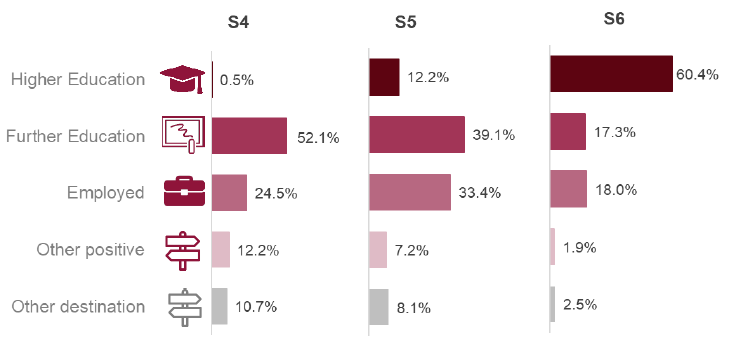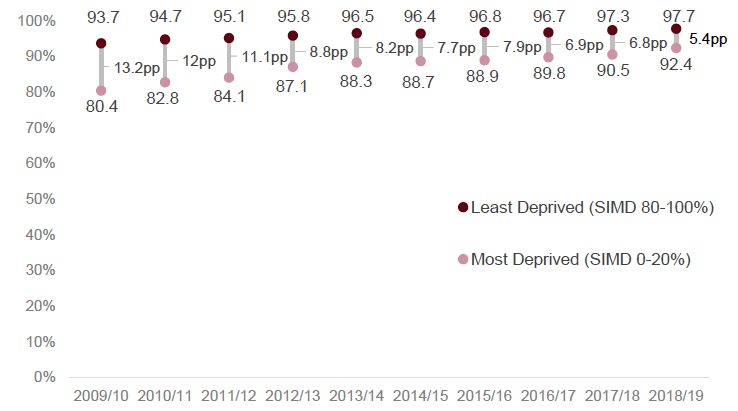Summary Statistics for Attainment and Initial Leaver Destinations, No. 2: 2020 Edition
This statistical publication provides information on the educational attainment and initial destinations of 2018/19 school leavers from publicly funded schools in Scotland.
Chapter 3: School Leaver Destinations
- 95.0 per cent of 2018/19 school leavers were in a positive initial destination (94.6 per cent for 2017/18) - the highest since 2009/10.
- 40.3 per cent of school leavers were in Higher Education (the highest proportion of all categories).
3.1 Destinations Data
All school leavers undertaking Personal Skills Development (PSD) are now recorded in a new standalone PSD category. For more information, see Chapter 6.1.
3.2 Destinations of School Leavers
Table 1 shows that 95.0 per cent of all 2018/19 school leavers were in a positive initial destination. This was higher than in 2017/18 (94.6 per cent).
Table 1 also shows that, 67.6 per cent of the 2018/19 leavers were in Higher or Further Education, around the same as for 2017/18 leavers (67.7 per cent).
The percentage of school leavers in employment has increased slightly from 22.7 per cent for 2017/18 leavers to 22.9 per cent in 2018/19.
The percentage of school leavers who were unemployed has decreased slightly from 5.0 per cent for 2017/18 to 4.5 per cent for 2018/19 leavers.
Table 1: Percentage of school leavers by initial destination category, 2013/14 to 2018/19
Column Percent (percentages may not total 100 due to rounding)
| Destination | 2013/14 | 2014/15 | 2015/16 | 2016/17 | 2017/18 | 2018/19 |
|---|---|---|---|---|---|---|
| Higher Education | 39.0 | 38.8 | 40.3 | 40.7 | 41.1 | 40.3 |
| Further Education | 26.3 | 27.6 | 26.6 | 26.8 | 26.5 | 27.3 |
| Training1 | 3.8 | 3.6 | 2.3 | 2.2 | 1.9 | 3.5 |
| Employment | 21.7 | 21.4 | 22.3 | 22.0 | 22.7 | 22.9 |
| Voluntary Work | 0.4 | 0.4 | 0.5 | 0.5 | 0.7 | 0.6 |
| Activity Agreement1 | 1.0 | 0.9 | 1.0 | 1.2 | 1.2 | n/a |
| Personal Skills Development | 0.2 | 0.4 | 0.5 | 0.4 | 0.4 | 0.5 |
| Positive Destinations | 92.6 | 93.2 | 93.5 | 93.9 | 94.6 | 95.0 |
| Unemployed Seeking | 6.1 | 5.3 | 5.0 | 4.4 | 3.7 | 3.1 |
| Unemployed Not Seeking | 1.1 | 1.0 | 1.2 | 1.4 | 1.3 | 1.4 |
| Unknown | 0.3 | 0.5 | 0.2 | 0.4 | 0.4 | 0.4 |
| Other Destinations | 7.4 | 6.8 | 6.5 | 6.1 | 5.4 | 5.0 |
| Number of Leavers | 51,416 | 52,491 | 52,305 | 51,300 | 49,748 | 49,760 |
1. For 2018/19, support previously recorded as Activity Agreements is recorded in the Training category. As a result, the proportion of school leavers recorded in the Training category is not directly comparable between 2018/19 and earlier years. For more information see section 6.2.
3.3 Destinations by Stage
The initial destinations of 2018/19 school leavers by stage of leaving (Chart 2) show:
- the majority of S6 leavers entered Higher Education (60.4 per cent);
- the most common initial destination for S5 leavers was Further Education (39.1 per cent) closely followed by Employment (33.4 per cent);
- the most common destination for S4 leavers was Further Education (52.1 per cent).
Chart 2: Initial destinations of school leavers by stage of leaving, 2018/19

1. Other positive includes Personal Skills Development, Training and Voluntary Work.
2. Other destinations include unemployed seeking, unemployed not seeking and unknown.
3.4 Destinations by Deprivation
Chart 3 shows that the percentage of school leavers in a positive initial destination has increased in 2018/19, for leavers from both the most deprived and least deprived areas, based on the Scottish Index of Multiple Deprivation (SIMD). This has led to a reduction in the deprivation gap from 6.8 percentage points in 2017/18 to 5.4 percentage points in 2018/19.
Table 2 provides a breakdown of initial school leaver destinations by SIMD. Amongst other things, it shows that pupils from the most deprived areas continue to be less likely to enter Higher Education than those from the least deprived areas.
In 2018/19, the most common destination for leavers from the most deprived areas was Further Education at 37.0 per cent.
In 2018/19, 7.2 per cent of leavers from the most deprived areas were unemployed, compared to 2.1 per cent of leavers from the least deprived areas.
A time series of destinations by SIMD is available in the supplementary tables. A list of these tables is available at background note 7.8.
Chart 3. Percentage of school leavers in a positive initial destination, by SIMD1, 2009/10 to 2018/19

pp = percentage point difference between most and least deprived SIMD quintile
1. Based on SIMD 2009 for 2009/10 and 2010/11, SIMD 2012 for 2011/12 to 2015/16 and SIMD 2016 for 2016/17, 2017/18 and 2018/19. More information on the Scottish Index of Multiple Deprivation can be found at: https://www.gov.scot/publications/scottish-index-multiple-deprivation-2016/.
Table 2: Percentage of school leavers by initial destination category by SIMD1, 2018/19
| Initial Destination | 0-20% (Most Deprived) | 20-40% | 40-60% | 60-80% | 80-100% (Least Deprived) | Percentage point gap2 | Total |
|---|---|---|---|---|---|---|---|
| Higher Education | 25.9 | 31.1 | 39.0 | 47.3 | 59.3 | 33.4 | 40.3 |
| Further Education | 37.0 | 32.8 | 27.2 | 21.8 | 17.0 | -19.9 | 27.3 |
| Training3 | 6.8 | 4.4 | 2.6 | 2.0 | 1.4 | -5.4 | 3.5 |
| Employment | 21.3 | 24.1 | 25.4 | 24.9 | 18.9 | -2.4 | 22.9 |
| Voluntary Work | 0.5 | 0.5 | 0.5 | 0.7 | 0.8 | 0.3 | 0.6 |
| Personal Skills Development | 0.8 | 0.5 | 0.5 | 0.2 | 0.3 | -0.5 | 0.5 |
| Positive Destinations | 92.4 | 93.3 | 95.2 | 96.9 | 97.7 | 5.4 | 95.0 |
| Unemployed seeking | 5.2 | 4.2 | 2.8 | 1.8 | 1.4 | -3.8 | 3.1 |
| Unemployed Not Seeking | 2.0 | 1.9 | 1.6 | 1.0 | 0.6 | -1.3 | 1.4 |
| Unknown | 0.5 | 0.6 | 0.5 | 0.4 | 0.2 | -0.3 | 0.4 |
| Other Destinations | 7.6 | 6.7 | 4.8 | 3.1 | 2.3 | -5.4 | 5.0 |
| Number of Leavers | 10,625 | 9,762 | 9,583 | 9,931 | 9,859 | 49,760 |
1. Based on SIMD 2016. More information on the Scottish Index of Multiple Deprivation can be found at: https://www.gov.scot/publications/scottish-index-multiple-deprivation-2016/.
2. The percentage point gap measures the difference between the most and least deprived pupils.
3. For 2018/19, support previously recorded as Activity Agreements is recorded in the Training category. For more information see section 6.2.
4. The way in which Personal Skills Development activity is categorised in these statistics has changed. For more information see section 6.1.
3.5 Destinations by Pupil Characteristics
Table 3 shows the percentage of school leavers who entered a positive initial destination by various characteristics.
The percentage of 2018/19 school leavers in positive initial destinations has increased for most groups, compared to 2017/18.
School leavers in 2018/19 with an additional support need (ASN) were less likely to go on to a positive initial destination, compared to leavers without a recorded ASN (91.9 per cent compared to 96.5 per cent).
Pupils of an Asian ethnic background tend to be more likely to go on to a positive initial destination. Rates for most ethnic groups in a positive destination for 2018/19 have increased compared to 2017/18.
Females continue to be more likely to enter positive destinations than males; 95.9 per cent of females and 94.2 per cent of males entered a positive destination.
Other Urban areas had the lowest proportion of leavers in positive destinations (94.5 per cent), compared to Accessible Rural areas which had the highest (96.1 per cent). Leavers from Large Urban areas have seen the largest increase between 2017/18 (93.6 per cent) and 2018/19 (95.0 per cent).
More information on destinations by pupil characteristics is available in the supplementary tables. A list of these tables is available at background note 7.8.
Table 3: Percentage of school leavers in a positive initial destination, by pupil characteristic, 2013/14 to 2018/19
| Percentage | ||||||
| Pupil Characteristic | 2013/14 | 2014/15 | 2015/16 | 2016/17 | 2017/18 | 2018/19 |
|---|---|---|---|---|---|---|
| Sex | ||||||
| Male | 91.5 | 92.0 | 92.6 | 92.9 | 93.5 | 94.2 |
| Female | 93.7 | 94.3 | 94.4 | 94.9 | 95.6 | 95.9 |
| Ethnicity1 | ||||||
| White - Scottish | 92.5 | 93.2 | 93.4 | 93.7 | 94.4 | 94.9 |
| White - non-Scottish | 92.7 | 92.2 | 94.0 | 94.7 | 95.1 | 95.8 |
| White - UK | n/a | n/a | n/a | n/a | n/a | n/a |
| White - Other | n/a | n/a | n/a | n/a | n/a | n/a |
| Mixed or multiple ethnic groups | 91.4 | 93.4 | 92.8 | 94.9 | 95.5 | 93.8 |
| Asian - Indian | 94.8 | * | * | * | 97.2 | 97.2 |
| Asian - Pakistani | 93.6 | 94.8 | 93.6 | 96.5 | 95.8 | 97.1 |
| Asian - Chinese | 96.5 | * | * | * | 98.0 | * |
| Asian - Other | 95.3 | 94.7 | 95.9 | 96.4 | 97.0 | * |
| African/ Black/ Caribbean2 | 93.7 | 92.6 | 93.8 | 95.3 | 96.9 | 96.4 |
| All other categories3 | 93.4 | 89.4 | 93.1 | 93.7 | 91.7 | 93.7 |
| Not Disclosed/Not known | 89.4 | 93.3 | 92.3 | 92.7 | 91.5 | 92.8 |
| Urban/Rural | ||||||
| Large Urban Areas | 91.6 | 92.1 | 92.4 | 93.0 | 93.6 | 95.0 |
| Other Urban Areas | 92.8 | 93.2 | 93.8 | 93.4 | 94.4 | 94.5 |
| Accessible Small Towns | 93.5 | 93.9 | 94.1 | 94.5 | 94.8 | 95.7 |
| Remote Small Towns | 93.0 | 94.3 | 94.6 | 94.7 | 95.0 | 94.9 |
| Accessible Rural | 93.5 | 94.0 | 94.2 | 95.5 | 95.9 | 96.1 |
| Remote Rural | 93.8 | 95.1 | 94.7 | 96.0 | 96.7 | 95.8 |
| Additional Support Needs4 | ||||||
| ASN | 87.6 | 88.7 | 89.1 | 89.8 | 90.9 | 91.9 |
| No ASN | 93.7 | 94.3 | 94.8 | 95.3 | 96.0 | 96.5 |
| All Leavers | 92.6 | 93.2 | 93.5 | 93.9 | 94.6 | 95.0 |
1. Some categories have been grouped together due to small numbers. Some categories contain between 100-200 leavers.
2. The 'African/ Black/ Caribbean' category includes 'African', 'African - Other', and the 'Caribbean or Black' categories.
3. 'All other categories' includes 'Other - other' and 'Other - Arab'.
4. Pupils who have a CSP, IEP, Child’s Plan are assessed or declared disabled or have another need.
Contact
Email: andrew.white@gov.scot
There is a problem
Thanks for your feedback